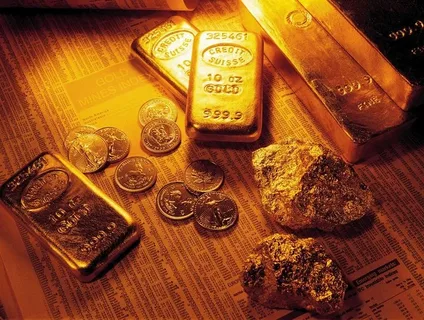The price of gold has been a topic of significant interest for both investors and economists in recent years. With the value of gold on the rise, it has become an important asset for investors looking to diversify their portfolios and protect against economic uncertainty. For economists, the increasing price of gold can be indicative of larger economic trends and can serve as a barometer for the health of the global economy. In this article, we will explore the implications of the rising price of gold for both investors and economists.
The rising price of gold is significant for investors and economists for several reasons. Firstly, as a traditional safe-haven asset, gold tends to perform well during times of economic uncertainty and market volatility. Therefore, a rising price of gold can signal concerns about inflation, geopolitical tensions, or the health of the global economy.
For investors, a rising price of gold can be seen as a signal to diversify their portfolios and hedge against potential risks. It can also present opportunities for profit, as the value of gold-related investments, such as mining stocks and exchange-traded funds (ETFs), may increase.
Economists closely monitor the price of gold as an indicator of market sentiment and future economic trends. A sustained increase in the price of gold can impact consumer behavior, business investment, and central bank policies, influencing the overall economic outlook.
Overall, the rising price of gold is significant for investors and economists as it reflects and influences market dynamics, risk management strategies, and economic forecasts.
The Surging Value of Gold: How it Affects Your Investments

The price of gold has been steadily rising in recent months, causing a significant impact on the investment market. Investors are closely monitoring the fluctuations and trends in the price of gold, as it plays a crucial role in diversifying their investment portfolios and hedging against economic uncertainties. With geopolitical events and market dynamics influencing the demand for gold, it’s essential for investors to stay informed and make strategic decisions based on the current price of gold.
The surging value of gold can have a significant impact on your investments. As gold prices rise, so too does the value of any gold-related investments you may have, such as gold ETFs or mining stocks. This can serve as a hedge against inflation and currency devaluation, making gold a popular choice for investors looking to diversify their portfolios. Additionally, the increased demand for gold can lead to higher profits for gold mining companies, potentially boosting the value of their stocks. It’s important to monitor gold prices and consider how they may affect your overall investment strategy.
Understanding the Fluctuating Price of Gold in the Market

Understanding the fluctuating price of gold in the market is essential for investors and traders. Gold has been considered a safe-haven investment for centuries and is often used as a hedge against inflation and currency fluctuations.
Several factors impact the price of gold, including supply and demand dynamics, macroeconomic trends, geopolitical tensions, and investor sentiment. The metal is also influenced by interest rates, central bank policies, and movements in the US dollar.
Gold prices can be volatile, experiencing significant fluctuations within short periods. As a result, investors closely monitor economic indicators, such as GDP growth, unemployment rates, and consumer confidence, to gauge the direction of gold prices.
Furthermore, market speculation and trading activity, particularly in futures and options markets, can also drive short-term price movements. Traders often use technical analysis, such as chart patterns and price momentum, to make buy or sell decisions.
In recent years, the increasing popularity of gold-backed exchange-traded funds (ETFs) has added another layer of complexity to gold price movements. These financial products can quickly expand or contract the supply of gold available for trading, influencing prices.
Overall, understanding the interplay of these factors is crucial for anyone looking to comprehend and navigate the fluctuating price of gold in the market. Successful gold investing requires a comprehensive understanding of both the metal’s intrinsic value and the broader market forces at play.
Investing in Gold: Is Now the Right Time?

Investing in gold can be a good option for diversifying one’s investment portfolio, especially during times of market uncertainty. Gold has historically been seen as a safe-haven asset, serving as a hedge against inflation and currency devaluation.
Factors such as geopolitical tensions, economic instability, and market volatility can drive up the demand for gold, potentially increasing its value. However, it’s important to note that gold prices can also be influenced by factors such as interest rates, currency movements, and supply and demand dynamics.
Before investing in gold, it’s crucial to conduct thorough research and consider consulting with a financial advisor to assess whether it aligns with your overall investment goals and risk tolerance. Additionally, be mindful of the costs and risks associated with gold investment, including storage and insurance expenses and the potential for price fluctuations.
Ultimately, whether now is the right time to invest in gold depends on individual circumstances, market conditions, and long-term financial objectives.
The Economic Impact of Rising Gold Prices

The economic impact of rising gold prices can be significant. As the price of gold increases, it can lead to higher revenues for gold mining companies and increased exploration and development activities. This can create job opportunities and stimulate economic growth in mining-dependent regions.
Additionally, rising gold prices can also impact the wider economy by influencing inflation and interest rates. Gold is often seen as a safe-haven investment during times of economic uncertainty, and its increasing price can reflect concerns about inflation or geopolitical instability. This can in turn affect central bank policies and interest rates.
On the other hand, higher gold prices can also lead to increased production costs for industries that use gold as a raw material, such as jewelry and electronics manufacturing. This can potentially lead to higher consumer prices for goods that contain gold.
Overall, the economic impact of rising gold prices is complex and can have both positive and negative effects on different sectors of the economy.
Factors Affecting the Price of Gold in Today’s Market
Some factors affecting the price of gold in today’s market include:
1. Economic data and market trends: Gold prices are influenced by economic indicators such as inflation rates, interest rates, and GDP growth. Market trends, such as stock market performance and currency value fluctuations, also impact gold prices.
2. Geopolitical events: Political instability, conflict, and uncertainty in global affairs can cause investors to seek safe-haven assets like gold, driving up its price.
3. Central bank policies: Changes in monetary policies, particularly those related to interest rates and quantitative easing, can impact the price of gold.
4. Demand for jewelry and industrial uses: Approximately half of the global gold demand is for jewelry and industrial purposes, and fluctuations in consumer demand can affect gold prices.
5. Investment demand: Gold is often seen as a hedge against inflation and currency devaluation, making it a popular investment choice during times of economic uncertainty.
6. Production and supply: Changes in gold production, supply disruptions, and mining costs can impact the price of gold.
These factors are just a few of the many variables that can influence the price of gold in today’s market. Understanding these dynamics is important for investors and traders looking to comprehend the movement of gold prices.
Gold Price Forecast: What to Expect in the Coming Months
Gold prices are expected to continue their upward trend in the coming months due to several factors such as global economic uncertainties, geopolitical tensions, and government stimulus measures. Analysts anticipate that the gold market will remain strong as investors seek safe-haven assets amidst the ongoing volatility.
The ongoing COVID-19 pandemic has also fueled demand for gold as a hedge against inflation and currency devaluation. The rollout of vaccines and potential economic recovery may temper some of the demand for gold, but many experts believe that its appeal as a diversification tool will keep prices elevated.
Additionally, with central banks continuing to maintain low-interest rates and unconventional monetary policies, gold is likely to remain an attractive investment option. The weakening of the US dollar, rising inflation expectations, and increasing investment demand from emerging markets could further bolster gold prices in the near future.
Overall, the consensus among market analysts is that gold prices are expected to remain well-supported and may even surpass previous highs in the coming months. However, as with any investment, it is important to consider the inherent risks and consult with a financial advisor before making any decisions.
Buying and Selling Gold: Navigating the Volatile Market
Buying and selling gold can be a lucrative investment, but it requires a deep understanding of the market and the factors that influence its volatility. The value of gold is affected by various economic, political, and social factors, making its price unpredictable at times.
One way to navigate the volatile gold market is to stay informed about current events and trends that may impact the price of gold. This includes closely monitoring the performance of major economies, geopolitical tensions, inflation rates, and currency fluctuations. Additionally, understanding the demand and supply dynamics of gold is crucial for making informed decisions.
It’s important to consider the different forms of owning gold, whether it be physical bullion, gold futures, or gold mining stocks. Each form of ownership comes with its own set of risks and benefits, and it’s essential to weigh these factors before entering the market.
For those looking to sell gold, timing is key. Keeping an eye on market trends and understanding when it may be advantageous to sell can help maximize returns. Additionally, exploring different selling options such as online platforms, auctions, or reputable dealers can help ensure a fair price for your gold.
Overall, navigating the volatile gold market requires diligence, knowledge, and a strategic approach to buying and selling. Keeping a close watch on market indicators and staying informed about global events can help mitigate risks and maximize opportunities in the gold market.
The Psychology Behind Investor Behavior in Gold Trading
Investor behavior in gold trading is influenced by various psychological factors. One such factor is the fear of economic instability, which leads investors to turn to gold as a safe haven investment. Gold is often perceived as a reliable store of value during times of economic uncertainty.
Additionally, the concept of scarcity plays a role in gold trading psychology. Gold is a finite resource, and this scarcity contributes to its perceived value. Investors are often drawn to assets that are perceived as rare or limited, and gold fits this criteria.
Another psychological factor at play in gold trading is the fear of missing out (FOMO). When the price of gold is rising, investors may feel pressure to join in on the trend in order to not miss out on potential profits. This can lead to impulsive and emotional decision making in the market.
On the flip side, the fear of loss can also drive investor behavior in gold trading. Investors may hold onto gold during market downturns out of fear of selling at a loss, even if it might be a rational decision to do so.
Overall, the psychology behind investor behavior in gold trading is a complex mix of fear, scarcity, and the desire for security in uncertain economic times. Understanding these psychological factors can help investors make more informed decisions in the gold market.
Gold vs. Other Investments: Comparing the Returns
Gold has historically been considered a safe haven asset and a hedge against market volatility. When comparing the returns of gold to other investments such as stocks, bonds, and real estate, gold has shown to have lower volatility and can provide diversification to a portfolio. In times of economic uncertainty, the price of gold often increases as investors seek safe assets.
However, it’s important to note that while gold can provide stability, it may not always outperform other investments over the long term. Stocks, for example, have historically provided higher returns than gold, although they do come with higher volatility and risk.
Bonds, on the other hand, typically offer lower returns than stocks but with less risk. Real estate can also provide steady returns and potential for appreciation over time.
Ultimately, the choice between gold and other investments depends on an individual’s risk tolerance, investment goals, and overall portfolio diversification strategy. Each investment has its own set of risks and potential rewards, and it’s important to carefully consider the factors that are most relevant to your specific financial situation.
The Role of Geopolitical Events in Shaping Gold Prices
Geopolitical events can significantly impact gold prices as they often create uncertainty in the global economy or financial markets. Events such as political instability, conflicts, trade wars, and economic sanctions can drive investors to seek safe-haven assets like gold, leading to an increase in demand and consequently, an increase in prices. Additionally, geopolitical tensions can also impact currency values, which in turn can influence gold prices as it is denominated in US dollars. Therefore, keeping a close eye on geopolitical events is essential for understanding and predicting gold price movements.
In conclusion, the rising price of gold is significant for both investors and economists. It indicates potential economic instability and serves as a safe-haven asset for investors looking to hedge against uncertainty. As the price of gold continues to climb, it is important for both parties to closely monitor its fluctuations and consider the implications for their portfolios and the broader economic landscape.
See also: gold detector
See also
https://www.gold.fr/
https://www.bullionbypost.fr/cours-de-lor/cours-de-lor-actuel/
https://or.fr/cours/or
https://www.aucoffre.com/cours-or
https://www.bullionbypost.fr/cours-de-lor/cours-de-lor-aujourdhui/







